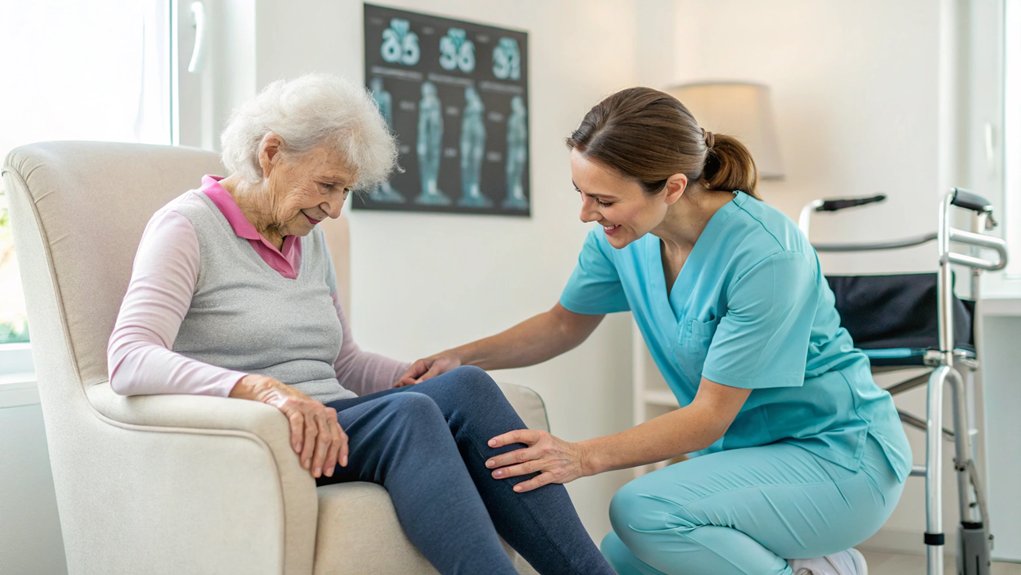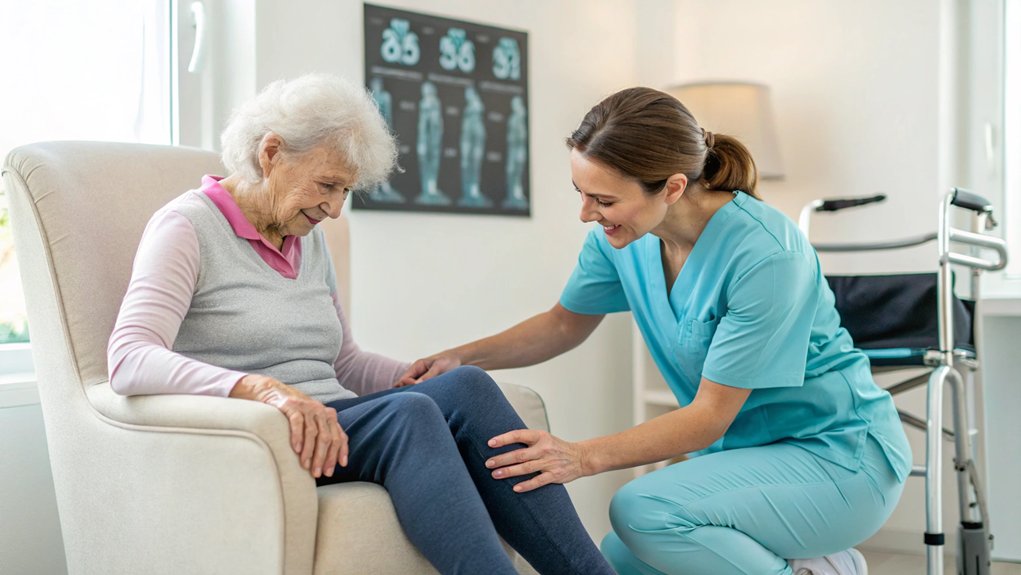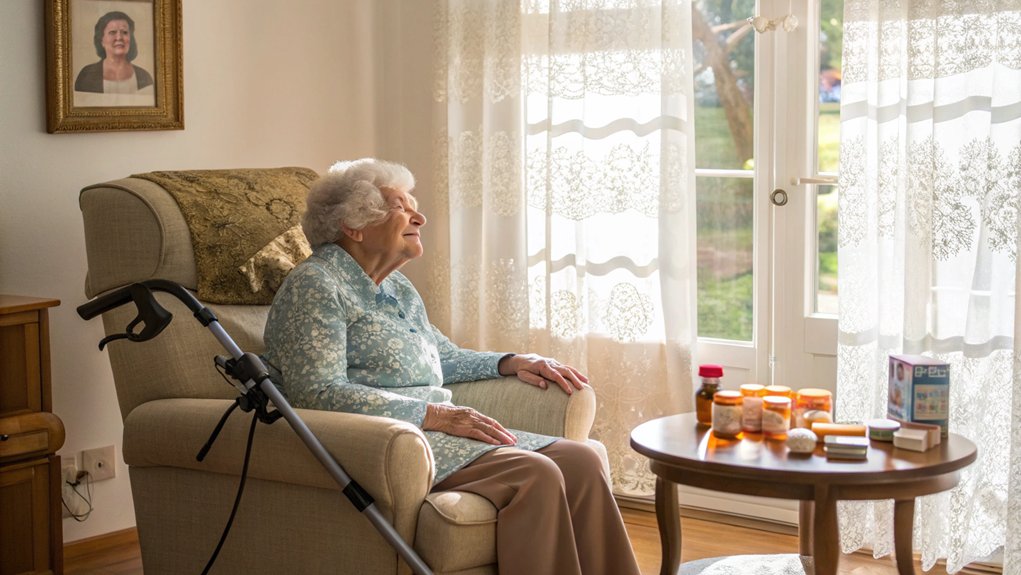Preventing Complications From Elderly Hip Pain After Fall

Prefer listening? Check out the podcast version of this article.
You might not know that hip fractures can occur without a complete break, often presenting subtle signs in the elderly after a fall.
Identifying these early is crucial to prevent complications.
Watch for increased pain, swelling, or difficulty bearing weight.
These symptoms can indicate a fracture or other damage.

Implementing safety measures at home, like grab bars, can reduce future fall risks.
Let’s explore how strategic interventions can facilitate recovery and support long-term well-being.
Table of Contents
Common Hip Damage Patterns in the Elderly
When assessing hip damage patterns in the elderly, you should first identify signs of fractures and tissue injuries, such as swelling, bruising, and sharp localized pain in the hip area.
Pay close attention to movement limitations, as these often indicate significant structural damage and require immediate action.
During the first 24 hours, monitor for warning signs like increased pain, inability to bear weight, and visible deformity, which necessitate urgent medical intervention.
Fracture and Tissue Injury Signs
Although hip injuries in the elderly often present varied symptoms, certain signs typically indicate fractures and tissue damage.
First, conduct a thorough injury assessment by checking for fracture symptoms such as acute pain, limb shortening, and external rotation.
Pain evaluation is pivotal; severe, localized pain often points to a fracture.
Discover Your Path to a Longer, Healthier Life!
Take our free quiz to see how your lifestyle measures up to the world's longest-living communities and receive expert tips for a healthier, longer life.
Take the QuizExpect mobility challenges, as individuals may be unable to bear weight on the affected side.
Tissue healing is contingent on early detection and intervention.
Recovery expectations should be discussed with healthcare providers, focusing on restoring mobility and preventing complications.
Monitor for signs of compromised blood flow to the affected area, which may impede tissue healing.
Addressing these indicators promptly helps optimize treatment outcomes and enhances recovery trajectories.

Pain Location and Movement Limitations
Identifying pain location and movement limitations is pivotal when assessing hip damage patterns in the elderly.
You should employ pain assessment techniques such as palpation, range-of-motion tests, and pain scales to determine the severity and impact on mobility.
Using mobility aids options like walkers or canes can help maintain independence while reducing stress on the injured hip.
Consider the emotional impact considerations, as pain and restricted movement can lead to frustration or depression.
Setting rehabilitation goals is crucial for restoring function, with a focus on enhancing strength and flexibility.
Don’t overlook nutrition support importance, as adequate protein intake aids recovery.
Effective caregiver communication strategies ensure that all parties understand treatment plans and progress, fostering a supportive environment for healing.
First 24 Hours Warning Signs
As you monitor an elderly patient in the first 24 hours following a fall, recognizing early warning signs of hip damage is crucial.
Assess pain levels meticulously, noting any increase which may signal a fracture.
Evaluate fall risk factors like balance instability or medication side effects.
Implement mobility aids to minimize further injury.
Observe for inability to bear weight, bruising, or swelling, which necessitate an immediate emergency response.
Initiate early rehabilitation strategies to facilitate recovery and maintain function.
Nutritional support is vital, ensuring adequate protein and calcium intake to promote bone healing.
Document findings systematically to inform treatment plans.
Prompt identification and intervention can significantly improve outcomes, reducing complications and enhancing the patient’s quality of life.
Emergency Steps and Medical Care
When an elderly person falls and sustains hip pain, immediate hospital evaluation is crucial to assess potential fractures and internal damage.
Prioritize post-fall pain management with evidence-based protocols, such as multimodal analgesia, to minimize discomfort and improve recovery outcomes.
Understanding key recovery timeline milestones, including the transition from acute care to rehabilitation, ensures comprehensive planning for restoring mobility and function.
Hospital and Medical Must-Dos
Prompt and efficient medical response is crucial in managing hip injuries in the elderly after a fall.
Hospital protocols should prioritize an immediate emergency response, ensuring swift diagnosis and treatment.
You must engage in comprehensive patient education, explaining the importance of rehabilitation services and discharge planning.
This step is vital for a smooth transition from hospital to home.
- Swift Diagnosis: Ensure timely imaging and evaluation.
- Rehabilitation Services: Initiate physical therapy early to optimize recovery.
- Follow-up Appointments: Schedule and attend regular check-ups to monitor progress.
These measures are critical in preventing complications and promoting recovery.

Adhering to structured hospital protocols and actively participating in the care process enhances outcomes.
Post Fall Pain Management Methods
Swift action in emergency situations is paramount for managing hip pain following a fall in elderly individuals.
Begin with pain relief strategies like medication to alleviate immediate discomfort.
Incorporate emotional support resources to address psychological distress.
Assess nutrition impact on recovery, ensuring adequate intake supports healing.
Explore mobility aids options to enhance safety and independence.
Rehabilitation techniques, such as targeted physical therapy, are crucial for restoring function.
Consider alternative therapies, including acupuncture, that may complement conventional approaches.
Here’s a helpful table:
| Pain Relief Strategies | Emotional Support Resources | Nutrition Impact |
|---|---|---|
| Medication | Counseling | Protein-rich diet |
| Ice application | Family involvement | Vitamin D & calcium |
| Positioning techniques | Support groups | Hydration |
Implementing these methods promptly can significantly improve outcomes.
Recovery Timeline Milestones
In the aftermath of a fall resulting in hip injury, immediate and structured medical intervention is paramount.
Establish clear recovery expectations with your healthcare team to guide you through this critical period.
Prioritize rehabilitation goals by engaging in physical therapy to enhance mobility and prevent complications.
Utilize mobility aids as prescribed to support safe and effective movement.
Emotional support is crucial; ensure open communication with caregivers and loved ones to address psychological impacts.
- Nutritional needs: Focus on a balanced diet to promote bone healing and overall health.
- Mobility aids: Employ devices like walkers or crutches to facilitate movement.
- Physical therapy: Participate in targeted exercises to regain strength and function.
These steps are essential for a successful recovery journey.
Daily Life Adjustments After Hip Pain

To mitigate complications following hip pain, you should prioritize home safety upgrades, such as installing grab bars and improving lighting to reduce fall risks.
Engaging in pain relief through movement, like targeted physical therapy exercises, can facilitate healing and enhance mobility.
Family support is crucial; establish guidelines to ensure effective communication and assistance with daily activities, fostering a supportive recovery environment.
Home Safety Upgrades
Enhancing home safety is crucial to reducing fall risks and facilitating recovery for those suffering from hip pain after a fall.
Implementing mobility aids, like grab bars and handrails, can significantly improve your stability.
Consider lighting improvements, such as motion-sensor lights, to enhance visibility and reduce trip hazards.
Flooring modifications, like non-slip mats or low-pile carpeting, minimize the risk of slips.
It’s essential to develop emergency plans, ensuring quick access to assistance when needed.
Incorporate assistive technology, such as medical alert systems, to provide peace of mind.
- Install mobility aids: Enhance stability with grab bars and handrails.
- Upgrade lighting: Use motion-sensor lights for better visibility.
- Modify flooring: Apply non-slip mats to prevent falls.
These evidence-based strategies will help create a safer home environment.
Pain Relief Through Movement
Although hip pain after a fall can be debilitating, integrating movement into daily life is essential for effective pain relief and recovery.
Begin with gentle stretching to promote flexibility and reduce stiffness.
Incorporate mobility exercises to enhance joint function, crucial for pain management.
Focus on therapeutic activities, such as water aerobics, which provide buoyancy and support, easing joint strain.
Ensuring safe movement is paramount—use assistive devices if needed to prevent further injury.
Follow a program that emphasizes gradual progression, allowing your body to adapt and strengthen over time.
Regularly consult healthcare professionals to tailor exercises to your specific needs and monitor progress.
Implementing these strategies can effectively manage pain and improve overall well-being post-fall.
Family Support Guidelines
When an elderly loved one experiences hip pain after a fall, family support becomes crucial in facilitating daily life adjustments and recovery.
Implement family involvement strategies to ensure effective communication techniques and provide emotional support resources.
Clear caregiver responsibilities are essential, focusing on rehabilitation encouragement and developing coping mechanisms.
Utilize evidence-based practices to enhance the recovery process and improve outcomes.
- Encourage open dialogue: Use effective communication techniques to understand their needs and preferences.
- Provide emotional reassurance: Access emotional support resources to help them feel secure and motivated.
- Engage in rehabilitation activities: Actively participate in and encourage physical therapy sessions to promote recovery.
Long Term Pain Prevention Tactics
To effectively prevent long-term pain after a hip injury, integrate strengthening and balance training into your routine, as these exercises are shown to enhance stability and reduce fall risk.
Adhere to medication safety rules by regularly reviewing prescriptions with your healthcare provider to minimize side effects that may impact balance or alertness.
Lifespan Comparison Tool
Compare the life expectancy by the U.S. State
Additionally, implement fall-proofing environment tips, such as securing loose rugs and ensuring adequate lighting, to create a safer living space.
Strengthening and Balance Training
Strengthening and balance training are critical components in the long-term prevention of pain and further injury following an elderly hip fracture.
Engaging in structured strengthening exercises enhances muscle support around the hip joint, reducing the risk of re-injury.
Balance techniques improve stability, thereby minimizing fall risk.
Collaborate with a physical therapist to develop personalized fitness routines focusing on mobility improvement and coordination drills.
Evidence shows that consistent adherence to these protocols significantly decreases complications related to hip fractures.
- Strengthening exercises: Target key muscle groups for enhanced joint support.
- Balance techniques: Incorporate activities like tai chi to improve stability.
- Coordination drills: Use controlled movements to boost neuromuscular function.
Adopting these strategies ensures a comprehensive approach to maintaining independence and optimizing recovery outcomes.
Medication Safety Rules
Although managing hip pain in the elderly involves several strategies, medication safety rules are crucial for long-term pain prevention.
You must prioritize regular prescription reviews to identify potential medication interactions that could worsen side effects.
Implement dosage adjustments based on the patient’s specific needs and tolerance levels.
It’s essential to monitor for side effects diligently, as they can significantly impact overall health and recovery.
Encourage adherence strategies, such as medication reminders or pill organizers, to ensure consistent treatment.
Additionally, emphasize medication education, helping the patient understand the purpose, benefits, and risks of each medication.
This comprehensive approach minimizes complications, optimizing pain management effectiveness in elderly patients recovering from hip injuries after a fall.
Fall Proofing Environment Tips
When aiming to prevent long-term pain from hip injuries in the elderly, fall proofing the living environment is crucial.
Start with a comprehensive home safety audit to identify potential hazards.
Proper hazard identification allows for targeted environmental modifications, such as securing loose rugs and installing grab bars.
Lighting enhancements, like adding brighter bulbs or motion-sensor lights, improve visibility and reduce fall risks.
Mobility aids are essential, providing stability and support during movement.
Implementing evidence-based fall proofing strategies can significantly reduce injury risks.
- Conduct regular home safety audits to ensure ongoing safety.
- Utilize mobility aids like walkers or canes to enhance stability.
- Improve lighting in dim areas to prevent accidents.
These proactive steps are vital for ensuring a safer environment and minimizing the risk of hip-related complications.
Conclusion
To prevent complications from hip pain after a fall, you should assess promptly, intervene quickly, and monitor diligently.
Implement safety measures at home, encourage gentle movements, and review medications regularly.
Engage family support, establish emergency plans, and promote physical therapy to enhance recovery.
By staying vigilant, taking preventative steps, and fostering a supportive environment, you can minimize risks and facilitate successful rehabilitation, ensuring a safer, more comfortable future for your loved ones.

 972-393-1699
972-393-1699





